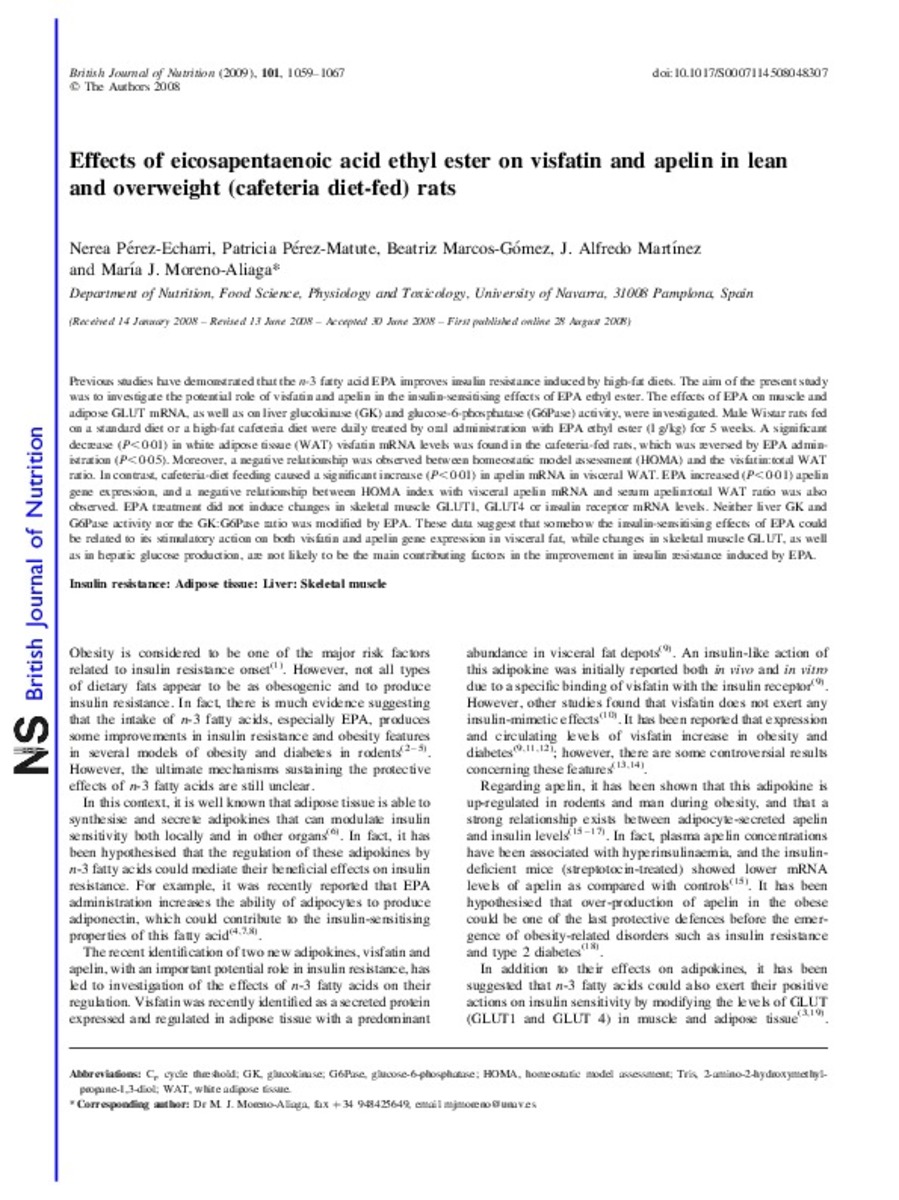Full metadata record
| DC Field | Value | Language |
|---|---|---|
| dc.creator | Perez-Echarri, N. (Nerea) | |
| dc.creator | Perez-Matute, P. (Patricia) | |
| dc.creator | Marcos, B. (Beatriz) | |
| dc.creator | Martinez, J.A. (José Alfredo) | |
| dc.creator | Moreno-Aliaga, M. J. (María Jesús) | |
| dc.date.accessioned | 2010-04-21T15:03:03Z | - |
| dc.date.available | 2010-04-21T15:03:03Z | - |
| dc.date.issued | 2009 | - |
| dc.identifier.citation | Perez-Echarri N, Perez-Matute P, Marcos-Gomez B, Alfredo Martinez J, Moreno-Aliaga MJ. Effects of eicosapentaenoic acid ethyl ester on visfatin and apelin in lean and overweight (cafeteria diet-fed) rats. Br.J.Nutr. 2009 Apr. 14;101(7):1059-1067. | es_ES |
| dc.identifier.issn | 0007-1145 | - |
| dc.identifier.uri | https://hdl.handle.net/10171/6934 | - |
| dc.description.abstract | Previous studies have demonstrated that the n-3 fatty acid EPA improves insulin resistance induced by high-fat diets. The aim of the present study was to investigate the potential role of visfatin and apelin in the insulin-sensitising effects of EPA ethyl ester. The effects of EPA on muscle and adipose GLUT mRNA, as well as on liver glucokinase (GK) and glucose-6-phosphatase (G6Pase) activity, were investigated. Male Wistar rats fed on a standard diet or a high-fat cafeteria diet were daily treated by oral administration with EPA ethyl ester (1 g/kg) for 5 weeks. A significant decrease (P,0·01) in white adipose tissue (WAT) visfatin mRNA levels was found in the cafeteria-fed rats, which was reversed by EPA administration (P,0·05). Moreover, a negative relationship was observed between homeostatic model assessment (HOMA) and the visfatin:total WAT ratio. In contrast, cafeteria-diet feeding caused a significant increase (P,0·01) in apelin mRNA in visceral WAT. EPA increased (P,0·01) apelin gene expression, and a negative relationship between HOMA index with visceral apelin mRNA and serum apelin:total WAT ratio was also observed. EPA treatment did not induce changes in skeletal muscle GLUT1, GLUT4 or insulin receptor mRNA levels. Neither liver GK and G6Pase activity nor the GK:G6Pase ratio was modified by EPA. These data suggest that somehow the insulin-sensitising effects of EPA could be related to its stimulatory action on both visfatin and apelin gene expression in visceral fat, while changes in skeletal muscle GLUT, as well as in hepatic glucose production, are not likely to be the main contributing factors in the improvement in insulin resistance induced by EPA. | es_ES |
| dc.language.iso | eng | es_ES |
| dc.publisher | Cambridge University Press | es_ES |
| dc.rights | info:eu-repo/semantics/openAccess | es_ES |
| dc.subject | Materias Investigacion::Ciencias de la Salud::Diabetes e hipertensión | es_ES |
| dc.subject | Materias Investigacion::Ciencias de la Salud::Endocrinología | es_ES |
| dc.title | Effects of eicosapentaenoic acid ethyl ester on visfatin and apelin in lean and overweight (cafeteria diet-fed) rats | es_ES |
| dc.type | info:eu-repo/semantics/article | es_ES |
| dc.relation.publisherversion | http://journals.cambridge.org/action/displayAbstract?aid=5326956 | es_ES |
Files in This Item:
Statistics and impact
Items in Dadun are protected by copyright, with all rights reserved, unless otherwise indicated.






